
|
|

Solutions
– Residential.
Each component in a Pro-active Environmental Technologies design
has a place and a purpose
in creating a corrected and balanced indoor air environment
for the whole home and all of its working elements and environs,
with the result that
everywhere you go,
the air is pure, and the space is safe . . .
" . . . So we can all breathe a little easier."SM



Inline Active Air Purification HVAC Probes
-- The start of total home protection, the help your duct works need

As designed for
nature, wind circulation patterns are vital to the health and vitality
of both the planet and its myriad environs. Breezes blow
literally around the world by circuitous pathways which expose the air
to elements that have been created to purify the air so that when it
gets dirty by pollution of any particular means, in fairly short order
it is cleansed and ready for use again. If it didn't, we all
would have been dead thousands of years ago.
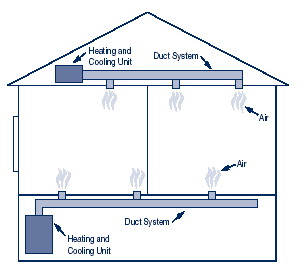
Most homes use planned circulated air for heating, ventilation, and air conditioning
("HVAC") by forcing the air to flow in patterns around the house in a
type of "wind". (Such a system is also known as a "forced air"
system.)
The "wind" blows or moves because one or more fans force it to do so.
The pattern for circulation is established by the design and
arrangement of the duct works. Where the air enters the system is
called the "return", and where it exits after being heated or cooled is
called the "vents". The better the plan and the cleaner the ducting, the
more efficient is the air system and hopefully the healthier is the air it
circulates.
But, unlike in nature, without the creation or addition of purifying
elements, the air will pick up dirt and other components which
will make it dirty. Once dirty, the air will continue to get
worse and worse.
|
    |
Not uncommonly, HVAC systems, while moving the air, will also
capture and harbor all manner of particulates, spores, and
pathogens which
will accumulate, breed, and be redistributed
throughout the entire indoor air space. The longer the process
continues the sicker will become the air space and the people who try
to breathe there. Buildings which breed contaminations which make
the environs sick are known as "sick buildings", and the condition is
known as "SBS" for "Sick Building Syndrome". |
The
first line of defense in keeping both the air ducts and the air space
clean is a regularly changed or maintained furnace or AC filter.
While it is true that such an item is only passive,
it is also true that the forced flow of air through the system and the
filter is captive, allowing a properly maintained and cleaned filter to
trap at least some of the particulates in the forced air stream and
take them out of circulation. Some or any removal is better than
nothing. Limited as passive filters may be overall, with a
modest amount of research, homeowners can maximize the the limnited job that
filters do and find ways to cut costs at the same time.
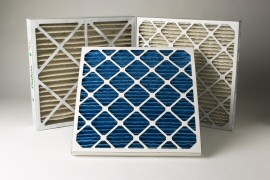 Furnace or AC filters come in a variety of styles and configurations. Your own HVAC
unit will have specific installation constraints related to the space
alloted to the length, width, and thickness of the area where the
filter is placed in the system. Almost without exception, it is
to be found somewhere on the return side of the unit where it can catch
whatever it is capable of capturing as the environmental air is on its
way back through the system before
the returning stream of air passes through the heating elements or the
cooling coils. The hope is that purer air going through the
system will lessen the clogging and ultimate cleaning necessary inside the working mechanism of the HVAC unit. It's a great theory, and with some care it almost works -- kinda, sorta. Furnace or AC filters come in a variety of styles and configurations. Your own HVAC
unit will have specific installation constraints related to the space
alloted to the length, width, and thickness of the area where the
filter is placed in the system. Almost without exception, it is
to be found somewhere on the return side of the unit where it can catch
whatever it is capable of capturing as the environmental air is on its
way back through the system before
the returning stream of air passes through the heating elements or the
cooling coils. The hope is that purer air going through the
system will lessen the clogging and ultimate cleaning necessary inside the working mechanism of the HVAC unit. It's a great theory, and with some care it almost works -- kinda, sorta.
Along with the physical size of a given filter, it is important to know that there are at least three basic types of filters.

The most common is a mechanical type filter, so named because it's abilities are limited
to the strict mechanics of its composition as dirty air passes through
it. Media may run from fiberglass to rubber foam to paper to
polymers and combinations thereof. The material may be flat (usually
the least effective) to pleated (usually the more effective because it creates far more surface area for trapping particles).
If the particles are big enough to get caught in the filtration media,
they are taken out of the air stream. If the particles are too
small to get caught, they will pass on through the system -- some remaining in the ducting itself and the rest out the
heated or cooled side where we get a chance to breathe them in and have
them lodge in our breathing apparatus. (usually the more effective because it creates far more surface area for trapping particles).
If the particles are big enough to get caught in the filtration media,
they are taken out of the air stream. If the particles are too
small to get caught, they will pass on through the system -- some remaining in the ducting itself and the rest out the
heated or cooled side where we get a chance to breathe them in and have
them lodge in our breathing apparatus.
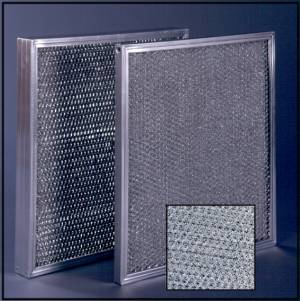 The
second common filter type is the electronic or electrostatic -- one
that uses some form of electricity (usually static) to grab hold of
particles passing through. While some may actually be wired and receive
a small amount of current, most are some form of metal mesh which
become charged with static electricity as the wind creates friction as
it is forced through the screen-like material. Like a kind of
magnet, it causes particles normally too small to get caught by the
screen like filter as they pass through to cling to the screen anyway
much in the same way we have seen a rubber comb charged with
static electricity pick up small pieces of paper or lint. One could
compare it to an electric bug screen except that it is dirt and not
insects that get caught. The
second common filter type is the electronic or electrostatic -- one
that uses some form of electricity (usually static) to grab hold of
particles passing through. While some may actually be wired and receive
a small amount of current, most are some form of metal mesh which
become charged with static electricity as the wind creates friction as
it is forced through the screen-like material. Like a kind of
magnet, it causes particles normally too small to get caught by the
screen like filter as they pass through to cling to the screen anyway
much in the same way we have seen a rubber comb charged with
static electricity pick up small pieces of paper or lint. One could
compare it to an electric bug screen except that it is dirt and not
insects that get caught.
A third not so common filter type is the gas phase adsorption.
The most common variety would be some kind of carbon filter.
This type is looking to trap gasses and odors more than
particulates per se.
Primarilly for the mechanical filters, their capacities or capabilities
are rated by a number referred to as a MERV number which stands for
"Minimum Efficiency Reporting Value". It is a rating system based
upon a filter's efficiency when tested according to a particular
testing standard (52.2) put forth by the American Society of Heating
Refrigeration and Air Conditioning Engineers (ASHRAE). With each
filter being subjected to the same testing procedure and grading
standard, it makes searching for an efficient filter much easier than
just reading manufacturers' comments and claims. As one would
expect, the higher the MERV rating, the more efficient the filter at
removing junk out of the air. But it does not mean that getting the
highest MERV rating is what is best for the situation.
The critical factor in comparing filter efficiencies or MERV ratings is understanding the relationship between the filter and the size of the particle it will
allow through. Ideally, we would want ALL particles of all sizes
trapped and taken out of the breathing space. The sheer physics
involved prevents that from happening. A filter with openings small
enough to capture everything would let little or no air through.
Further, the smaller the openings in the filter, the harder the system
has to work to force the air through the system. Overloading the system
adds to the operating energy costs on the front end and burns out the
fans, compressors, etc., on the back end. Also, if the system's fan is
not moving a sufficient volume of air at an appropriate velocity, there
will be pockets of stagnant air throughout the building which, along
with being uncomfortable (not being warm enough in the winter or cool
enough in the summer), will allow mold, bacteria, and other pathogens
to build up, making the building sick.
relationship between the filter and the size of the particle it will
allow through. Ideally, we would want ALL particles of all sizes
trapped and taken out of the breathing space. The sheer physics
involved prevents that from happening. A filter with openings small
enough to capture everything would let little or no air through.
Further, the smaller the openings in the filter, the harder the system
has to work to force the air through the system. Overloading the system
adds to the operating energy costs on the front end and burns out the
fans, compressors, etc., on the back end. Also, if the system's fan is
not moving a sufficient volume of air at an appropriate velocity, there
will be pockets of stagnant air throughout the building which, along
with being uncomfortable (not being warm enough in the winter or cool
enough in the summer), will allow mold, bacteria, and other pathogens
to build up, making the building sick.
Any solution has to be a sustainable one. So what we have to achieve is
a proper balance between removing an acceptable percentage of
particulates over a specified micron size AND looking to a different
type of technology to handle the rest.
|
Welcome to the solution. The appropriately sized and placed Inline Active Air Purification HVAC Probe adds a whole other dimension to indoor air quality. Installed in the plenum above the coils of each A/C
unit, each unit is an indexed device which utilizes the RCI (“Radiant
Catalytic Ionization”)
produced by a germicidal broad spectrum high-intensity UVX lamp
reflected off of a specially engineered matrix with a patent-pending
proprietary multi-metallic coating.
Unlike
what many have seen in the past, this is NOT a UV bulb whose
effectiveness is limited to the
few square feet it shines upon. The Inline HVAC Active Air Purification Probe utilizes your HVAC fan to deliver safe oxidizers and
super-oxide ions throughout your home, amplifying the effectiveness of your
existing air purification units and dramatically improving the quality of air
passing through your HVAC system.
Sized for small to
monstrous HVAC systems, this patented catalytic converter literally produces an oxidizing plasma which circulates, purifies, and
sanitizes
the interiors of the duct work system to prevent the buildup and
proliferation of
unwanted pathogens, molds, and fungi therein. The oxidizing plasma then moves out and
circulates into the rest of the indoor air space to augment the other
air purifying components which together provide a clean, crisp, safe atmosphere . . . "So we can all breathe a little easier."
These powerfully effective Inline Active Air Purification HVAC Probes can do wonders for the overall
air quality in your home if sized and placed to maximize their use.
They come in several sizes and configurations, so be sure to
contact Pro-active Environmental Technologies to configure the
installation best for your particular needs.
Keep in mind, while the Inline Active Air Purification HVAC Probes
are designed to provide the baseline active air purification in the
home, they are part of a total home indoor Pro-active Environmental
Technologies package which takes into account all of the particular
needs and challenges of your unique air space. Therefore, the Inline Active Air Purification HVAC Probes are best utilized with other devices which address those issues, such as the Free Standing Whole Home Active Air Purifier Series or any of the other Active Air Purification units. |
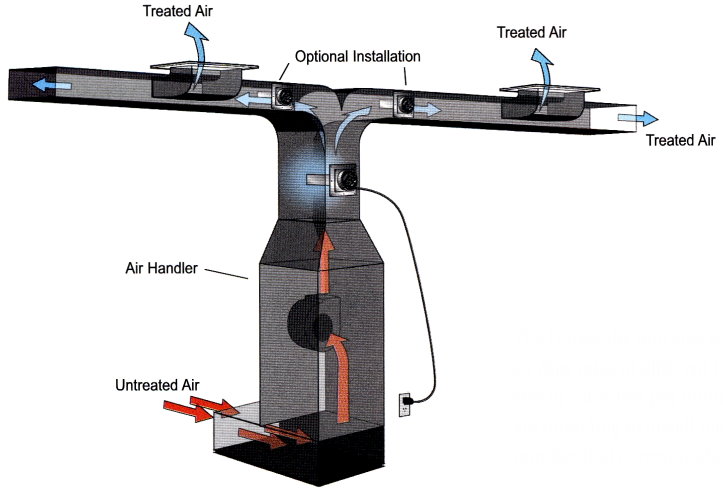 |
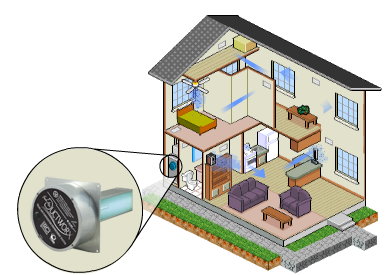
A Great Start and Compliment to a Whole House Solution
|
  |
 |
  |

Inline
Active Air HVAC Probe Series -- The start of total
home protection, the help your duct works need
Mini
Inline Active Air HVAC Probe -- Just like the big guys for standalone HVAC systems
Free-Standing Whole Home Active Air Purier Series -- All the benefits of outside fresh air on the inside
Super
Portable Active Air Room Refresher -- "Fresh. Out of the box."(sm)
Wall
Mounted Active Air Purifier -- The ultimate plug-in
Book
Shelf Fanless Active Air Purifier -- The purifying spectrum of UVX from the sun
Mobile
Active Air Purifier - Take your fresh air to go
Pinpoint Need Specific Active Air Purifier - Focus just what you need right where you need it
Refrigerator
Active Air Purifier - Keepin' it clean and refreshed in the fridge
5K
HD Active Air Ionizer / Sanitizer -- Up to 5000 SF of heavy duty active air purification
Light
to Medium Duty Active Air Electronic Particulate Ionizer
Top
of This Page
Previous Section
Next Item
|
 

All materials not supplied by manufacturers or others are
Copyright
2005 - 2008 -- breathe-easier.com
-- All Rights Reserved
|
 |


Inline Active Air HVAC Probes -- The start of total home protection, the help your duct works need


Mini Inline Active Air HVAC probe -- Just like the big guys for standalone HVAC systems

Free Standing Whole Home Active Air Purifier Series -- All the benefits of outside fresh air on the inside
Super Portable Active Air Room Refresher. "Fresh. Out of the box."TM
 Wall Mounted Active Air Purifier -- The ultimate plug-in
Wall Mounted Active Air Purifier -- The ultimate plug-in
 Book Shelf Fanless
Book Shelf Fanless
Active Air Purifier -- The purifying spectrum of UVX from the sun
 Mobile Active Air Purifier -
Mobile Active Air Purifier -
Take your fresh air to go
5K HD Active Air
Ionizer / Sanitizer -- Up to 5000 SF of heavy duty active air purification
Light to Medium Duty Active Air Electronic Particulate Ionizer
Pinpoint Need Specific Active Air Purifier - Focus just what you need right where you need it



Personal Solutions
You
don't have to be at the mercy of whatever wherever. This is where you can expore some exciting options you can have with anytime or take with wherever you go.


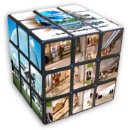 Commercial Solutions
Commercial Solutions

|



































 The
second common filter type is the electronic or electrostatic -- one
that uses some form of electricity (usually static) to grab hold of
particles passing through. While some may actually be wired and receive
a small amount of current, most are some form of metal mesh which
become charged with static electricity as the wind creates friction as
it is forced through the screen-like material. Like a kind of
magnet, it causes particles normally too small to get caught by the
screen like filter as they pass through to cling to the screen anyway
much in the same way we have seen a rubber comb charged with
static electricity pick up small pieces of paper or lint. One could
compare it to an electric bug screen except that it is dirt and not
insects that get caught.
The
second common filter type is the electronic or electrostatic -- one
that uses some form of electricity (usually static) to grab hold of
particles passing through. While some may actually be wired and receive
a small amount of current, most are some form of metal mesh which
become charged with static electricity as the wind creates friction as
it is forced through the screen-like material. Like a kind of
magnet, it causes particles normally too small to get caught by the
screen like filter as they pass through to cling to the screen anyway
much in the same way we have seen a rubber comb charged with
static electricity pick up small pieces of paper or lint. One could
compare it to an electric bug screen except that it is dirt and not
insects that get caught. relationship between the filter and the size of the particle it will
allow through. Ideally, we would want ALL particles of all sizes
trapped and taken out of the breathing space. The sheer physics
involved prevents that from happening. A filter with openings small
enough to capture everything would let little or no air through.
Further, the smaller the openings in the filter, the harder the system
has to work to force the air through the system. Overloading the system
adds to the operating energy costs on the front end and burns out the
fans, compressors, etc., on the back end. Also, if the system's fan is
not moving a sufficient volume of air at an appropriate velocity, there
will be pockets of stagnant air throughout the building which, along
with being uncomfortable (not being warm enough in the winter or cool
enough in the summer), will allow mold, bacteria, and other pathogens
to build up, making the building sick.
relationship between the filter and the size of the particle it will
allow through. Ideally, we would want ALL particles of all sizes
trapped and taken out of the breathing space. The sheer physics
involved prevents that from happening. A filter with openings small
enough to capture everything would let little or no air through.
Further, the smaller the openings in the filter, the harder the system
has to work to force the air through the system. Overloading the system
adds to the operating energy costs on the front end and burns out the
fans, compressors, etc., on the back end. Also, if the system's fan is
not moving a sufficient volume of air at an appropriate velocity, there
will be pockets of stagnant air throughout the building which, along
with being uncomfortable (not being warm enough in the winter or cool
enough in the summer), will allow mold, bacteria, and other pathogens
to build up, making the building sick.






















